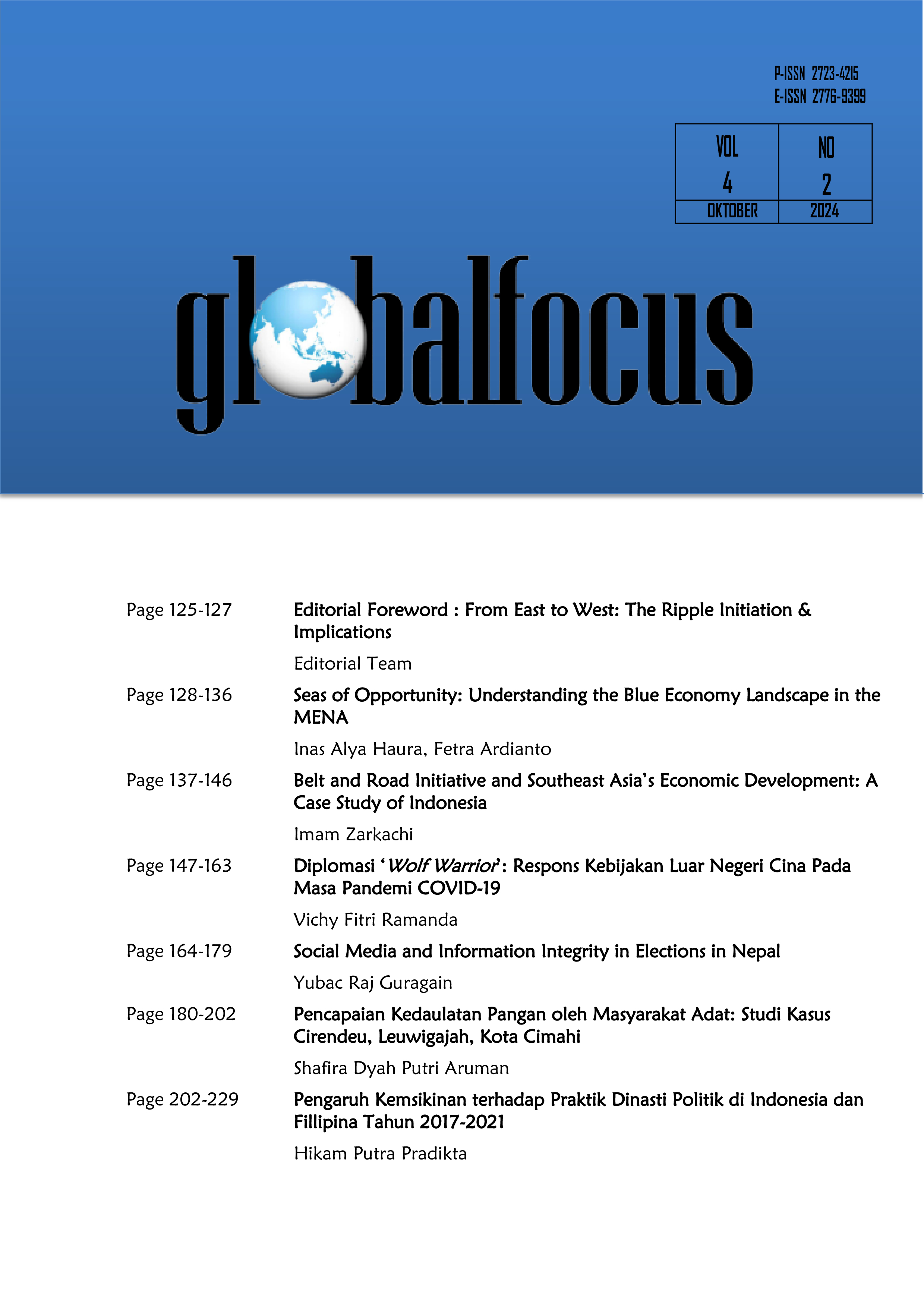Social Media and Information Integrity in Elections in Nepal
Main Article Content
Abstract
Article Details

This work is licensed under a Creative Commons Attribution-NonCommercial 4.0 International License.

Authors who publish with this journal agree to the following terms:
- Authors retain copyright and grant the journal the right of first publication with the work simultaneously licensed under a Creative Commons Attribution License-NonCommercial 4.0 International that allows others to share the work with an acknowledgment of the work's authorship and initial publication in this journal for non-commercial purposes.
- Authors are able to enter into separate, additional contractual arrangements for the non-exclusive distribution of the journal's published version of the work (e.g., post it to an institutional repository or publish it in a book), with an acknowledgment of its initial publication in this journal.
- Authors are permitted and encouraged to post their work online (e.g., in institutional repositories or on their website) prior to and during the submission process, as it can lead to productive exchanges, as well as earlier and greater citation of published work.
References
Armoudian, M. and Crigler, A.N. (2010). Constructing the Vote, Media Effects in A Construction Model. In Jan E. Leighley (eds). Oxford Handbook of American Elections and Political Behavior. Oxford University Press. New York.
Aryal, K. (2023). Mass Media in Elections and Changed Information Ecosystem. L. Upadhaya and K. D. Bhattarai (eds.). Nepali Media: Issues of Ethics and Sustainability in Digital Age. Media Year Book 2022/23. Vol.- 3. No.-3. Tilganga, Kathmandu.
Bateman, J. and Jackson, D. (2024) Countering Disinformation Effectively: An Evidence-Based Policy Guide. Carnegie Endowment for International Peace.
Bimber, B.(2003).Information and American Democracy: technology in the evolution of political power. Cambridge University Press . Edinburgh Building, Cambridge.
Bista, D.B. (1991). Fatalism and development: Nepal's struggle for modernization. Orient Longman, Calcutta.
Cosentino, G. (2020). Social Media and the Post-Truth World Order: The Global Dynamics of Disinformation. Springer Nature. Switzerland AG.
Dahal, D. (17 Nov.2022). “No Not Again”: What Nepalis need to be aware of? My Republica. Accessed on 25 July 2024 from https://myrepublica.nagariknetwork.com/news/no-not-again-what-nepalis-need-to-be-aware-of/
Davenport, T.H. (1997). Information Ecology: Mastering The Information and Knowledge Environment. Oxford University Press. New York.
Election Commission of Nepal. (Dec. 2023) Seventeenth Annual Report. Kantipath, Kathmandu.
Election Commission of Nepal. Election Codes of Conducts, 2015, 2022. Accessed on 5 June 2024. Retrieved from https://election.gov.np/admin/public//storage/HoR/LAw/.
Election Commission of Nepal. Press Releases. Accessed on 5 June 2024. Retrieved from https://election.gov.np/np/press-release.
Election Commission of Nepal.Policy on the Use of Social Media in Election Management (2020). Accessed on 5 June 2024. Retrieved from https://election.gov.np/source/Resources%20Other/05_ECN_Social_Media_Policy_ Nepali_20210610_v1.pdf.
Election Commission of Nepal.Third Strategic Plan (2019 - 2024). Accessed on 5 June 2024. Retrieved from https://election.gov.np/np/page/other-resources.
Fulmer, I.S., Barry, B and Long, A.D (2009). Lying and Smiling: Informational and Emotional Deception in Negotiation. Journal of Business Ethics. DOI 10.1007/s10551-008-9975-x.
Gurung, C.B. (2023). An Overview of Nepal’s Media Literacy Drive. L. Upadhaya and K. D. Bhattarai (eds.). Nepali Media: Issues of Ethics and Sustainability in Digital Age. Media Year Book 2022/23. Vol.- 3. No.-3. Tilganga, Kathmandu.
Hinck, R.S., Cooley, S. and Kluver, R. (2020). Global Media and Strategic Narratives of Contested Democracy: Chinese, Russian, and Arabic Media Narratives of the US Presidential Election. Routledge. New York and London.
Huckfeldt, R. and Sprague, J. (1995). Citizens, Politics and Social Communication: Information and Influence in an Electoral Campaign. Cambridge University Press. UK.
Humprecht, E. (2023). The Role of Trust and Attitudes toward Democracy in the Dissemination of Disinformation - a Comparative Analysis of Six Democracies. Digital Journalism. Taylor and Francis Group. DOI: 10.1080/21670811.2023.2200196
Koirala, K.R. (2023). Tacking Multiple Security Threats Emanating from False Information in Digital Media Platform. L. Upadhaya and K. D. Bhattarai (eds.). Nepali Media: Issues of Ethics and Sustainability in Digital Age. Media Year Book 2022/23. Vol.- 3. No.-3. Tilganga, Kathmandu.
Kumar, R. (18 April 2022). Electoral Competition in Social Networks (“Samajik Sanjalma Chunabi Sangram”). Accessed on 3 July 2024 from https://www.himalkhabar.com/news/129330.
Lau, R.R. and Redlawsk, D.P. (2006). How Voters Decide: Information Processing during election campaigns. Cambridge University Press. New York.
Ministry of Finance, Government of Nepal. Economic Survey 2007/2008. Singhadurbar, Kathmandu.
Ministry of Finance, Government of Nepal. Economic Survey 2021/2022. Singhadurbar, Kathmandu.
Mossberger, K. and Tolbert, C.J. (2010). Digital Democracy: How politics online is changing electoral participation. In J. E. Leighley (eds.), The Oxford Handhook of American Elections and Political Behaviour. Oxford University Press. New York.
National Statistics Office. (2023). National Population and Housing Census, 2021. Thapathali. Kathmandu.
Nepal Law Commission. Constitution of Nepal. Accessed on 20 July 2024. From https://lawcommission.gov.np/en/wp-content/uploads/2021/01/Constitution-of-Nepal.pdf.
Nepal Law Commission. Election Commission Act, 2017. Accessed on 5 June 2024. Retrieved from https://lawcommission.gov.np/en/wp-content/uploads/2021/01/Election-Commission-Act-2073-2017.pdf.
Nepal Law Commission. Electronic Transaction Act, 2008. Accessed on 25 May 2024. Retrieved from https://lawcommission.gov.np/en/?p=16954.
Press Council Nepal, (15 June 2022). Local Level Election 2022: Special Monitoring of Codes of Conducts in Media (translated from Nepali). Final Report. Sanchargram, Tilganga, Kathmandu.
Prior, M. (2007). Post-Broadcast Democracy: How Media Choice Increases Inequality in Political Involvement and Polarizes Elections. Cambridge University Press. UK.
Rai, S and Ghimire, R. (2 May 2022). Changes in the Election Campaigning in six Decades: From Physical to Digital (translated from Nepali). Onlinekhabar. Accessed on 10 June 2024. from https://www.onlinekhabar.com/2022/05/1119564.
Robinson, J. (2004). Emotion: Biological Fact or Social Construction? In R. C. Solomon (eds.) Thinking about Feeling: Contemporary Philosophers on Emotions. Oxford University Press.
Task Force. (28 May 2022). Report of the Task Force for Digital Media and Social Network Monitoring for Local Elections of 2022.
The Kathmandu Post.(7 Nov.2022).Supreme Court issues interim order in favour of ‘No Not Again’ campaign. Accessed on 3 July 2024, from https://kathmandupost.com/national/2022/11/06/supreme-court-issues-interlocutoryinterim-order-not-to-take-action-against-no-not-again-campaigners.
UNDP (2024). Information Integrity for Electoral Institutions and Processes: Reference Manual for UNDP Practitioners. Oslo: UNDP Global Policy Centre for Governance.

